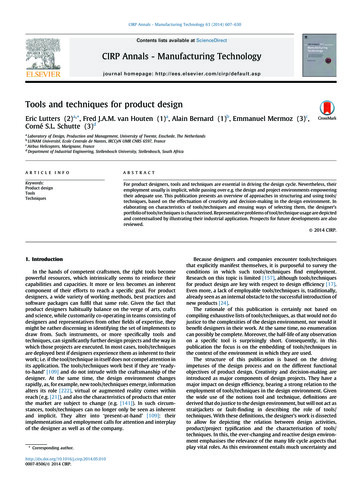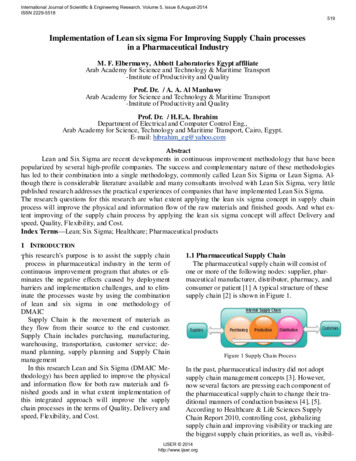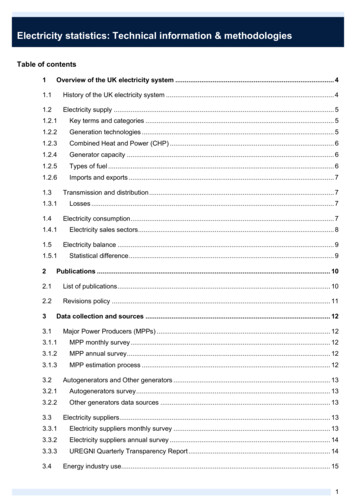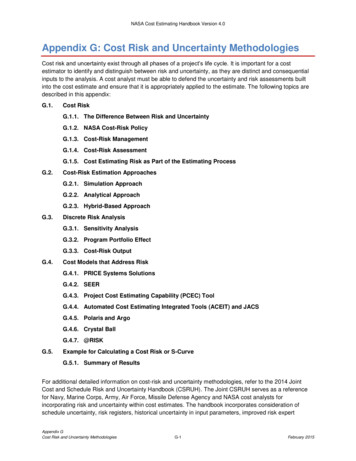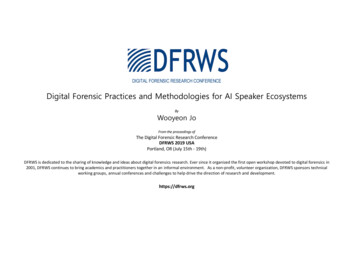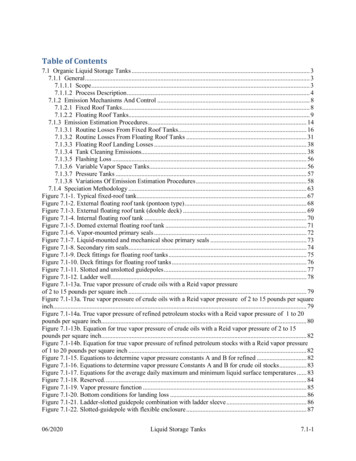
Transcription
Journal of Technology ResearchMethodologies, tools, and techniques in practiceractice forWeb application developmentMonica LamCalifornia State University, SacramentoAbstract:This exploratory study investigates what methodologies, tools, and techniques are usedby Web developers. The survey results from over 300 Web developers in USA show that RAP,XP, WSDL, and WebML are used by practitioners. The PCA indicates that WebML is uniquelyassociated with HIPO Chart, WAE, Decision Table, Program Flowchart, Deployment Diagram,and Pseudocode for Web application development. Guidelines for determining when to use whatmethodology are needed.Keywords: Methodologies, Web Application Development, Explorative Study, WebMLMethodologies, Tools, and Techniques, Page 1
Journal of Technology ResearchINTRODUCTIONWeb presence is nowadays essential for business operation, marketing, and strategy.There is no doubt that the majority of information systems to be developed in the future will beWeb-based even for internal purposespurposes. Strategic collection and utilizationn of information viadifferent kinds of Web-basedbased applications can determine whether a business will be successful.successfulThis study definess a Web application as a software system that relies on the Web as itsinteraction medium with the end--users to create, exchange,change, and modify data for transactionrequirements. As Web applications have become more and more important, how to ensure thesuccess of their development is an issue of interest and practical value to practitioners, educators,and researchers. Though Web applications fall under the umbrella of software systems, they areunique in terms of user recognition, user environment, communication control, testingrequirement, security issues, interface requirements, feedback mechanism, functionality design,desiand life cycle.Methodologies for application development are stepstep-by-stepstep procedures to carry out thedevelopment activities in different phases of a system development life cycle. A methodologyhas its own assumptions about the reality, its own techniqueschniques to support working principles andenforce discipline, and its own tools to generate the deliverables for activities. In other words,there are a collection of specific techniques and tools for a certain development methodology. Asearch of the literature reveals that although there are many suggested methodologies, tools, andtechniques for Web application development, they have not been consolidated into a few provenapproaches for Web developers. What are the methodologies being used by practitionerspracttodevelop their Web applications when there are no solid guidelines? Are practitioners using someheuristic methods developed by themselves, some modified methodologies from the literature, ornot using any methodologies at all? If practitionerpractitionerss are using some methodologies for Webapplication development, are there any problems? What are those problems? What dopractitioners need in order to solve those problems? This explorative survey study attempts toanswer the above questions.LITERATURE BACKGROUNDThe literature of Web application development is mainly divided into the two groups oftechnology focus and empirical study focus. For technology focus, Conallen (1999,(1999 2003)discusses modeling Web application using Web Application Extension (WAE) to UnifiedModeling Language (Booch 19991999). Web Modeling Language (WebML) is developed as agraphic notation and a textual XML syntax for specifying complex Web sites at the conceptuallevel (Ceri 2000). Chen and HeatHeathh (2001) present a modified prototyping method (MPM) thatcaptures Web application components, clientclient-side processing, and server-sideside processing toaddress scalability, load balancing, security, maintainability, interfacing with legacy systems,and fast development. Standingg (2002) proposes the Internet Commerce DevelopmentMethodologyethodology (ICDM) that provides a management strategy and a development strategy coveringmeta-development,development, user involvement, site and component development, requirements analysis,functional framework, physical architecture, and evolution. Avison and Fitzgerald (2003)classify system methodologies into prepre-methodologymethodology era (no methodology), early methodologyera (waterfall life cycle and flowchart), methodology era (structured design, entity-relationshipentitydiagram, prototyping, CASE),, and postpost-methodology era. We are now in the post-methodologypostMethodologies, Tools, and Techniques
Journal of Technology Researchera where methodologies are ad-hochoc and trial-and-errorerror based on developers' personal knowledgeand experience. Object-orientedoriented technology and aapplicationpplication frameworks are the dominantprogramming concepts and tools used by Web developers nowadays.For the empirical study focus, Taylor et al. (2001) classify the skill sets required for Website development into the three overlapping sets of technical, business, and analytical based oncases studies in twenty UK organizations. Kautz et al. (2004) identify the followingcharacteristics of methodology utilization from three different projects in a major Danishsoftware developmentopment company. First, there is no universally applicable methodology forsystem development. Due to the lack of knowledge or time, developers are usually forced tobegin the actual physical modeling very early in the development process without takingadvantagedvantage of conceptual and logical analysis advocated by methodomethodology.logy. Second,methodologies are used symbolically to provide comfort and confidence to developers and endendusers. Third, developers prefer incremental methodologies to sequentially organizedmethodologies. As functional requirements are guaranteed to change during the developmentdevelopprocess, a formal method that iterateiterates is necessary. Fourth, methodology adoption depends onmanagement support, explicit adoption, and cooperation agreement among all parties.partiLang andFitzgerald (2006), in a survey of 164 companies, identify the hybrid, customized, or proprietaryin-househouse method or approach as the most adopted methodology in Web/hypermedia systemdesign (23%), followed by traditional SDLC (22%), aandnd rapid or agile development methods(15%).In terms of development techniques, sscreencreen prototypes (97%), flowcharts (95%), 2D sitemapping techniques (91%), storyboards (85%), and entityentity-relationshiprelationship diagrams (74%) are thetop five techniques used by Webb developers. Masrek et al. (2008), in a survey of 66 companiesin Malaysia, found that the mostly adopted development methodologies for Web applications arein-househouse methodology (48.48%), rapid application development (36.36%), and UnifiedModeling Languageage (34.85%). The most popular techniques used are data flow diagrams(59.09%), flowcharting (57.58%), prototyping (50%), entityentity-relationshiprelationship diagrams (48.48%), andproject management (42.42%). Smolander and Rossi (2008), based on a case study, concludethat the benefit level provided by UML for enterpriseenterprise-wide e-businessbusiness architecture is medium fortechnical and language requirements but low for organizational requirements.Overall thehe literature has provided some background information regarding whatpractitioners are using for methodologies, tools, and techniques. However, the results fromavailable studies are limited to case study, small sample size, nonnon-USA company basis, or simpleranking analysis. This explorative study focuses on the importance of methodologies, tools, andtechniques for the success of Web application development as well as their relationship using alarge sample of over 300 respondents in USA. Comments are also collected to address thedeficiency and problems of existing methodologies as well as the requisite skills and knowledgefor Web developers.SURVEY INFORMATIONA preliminary questionnaire was developed and submitted to ten Web developers forpretest. Feedback from pretest was used to revise the questionnaire in terms of terminologyclarification, format, ordering of questions, and addition of questions. The survey wasadministered by an Internet research company to a sample of 1500 contacts in a period of 4weeks. There were one initial invitation email and one followfollow-upup reminder email to contacts. ToMethodologies, Tools, and Techniques
Journal of Technology Researchprovide incentive for participation, for each completed survey, a donation of 10.00 is made to acharity organization of the respondent's choice. The initial collection of responses was filteredusing a reliability test based on respondents' answers to multiple pairs of variables measuring thesame concepts. If a respondent's answers to those pairs of varivariablesables differ more than 3 points ina scale of 1-7,7, that respondent is deleted from the final data set for analyses. The reliability testgenerated a total of 312 valid responses for analyses. The valid response rate is 21%21 of thesurvey sample. Appendixes I - III have the main questions for methodologies, developmentphases, and tools and techniques in this survey.Respondents were asked to evaluate the significance (in a scale of 11-77 from notsignificant at all to very significant) of methodologies, ddevelopmentevelopment phases, and tools andtechniques for Web application. Tables 1 - 5 respectively show the company type, number ofemployees, annual sales, job title of the respondent, and the number of Web applicationsdeveloped by the company in the past 3 years. The remaining of this paper includesinclude thediscussion of evaluationtion results of the significance of methodologies, development phases, andatechniques; the discussion of principle component analysis results for the winning combinationof methodologies, development phases, and development techniques for Web application;summary of open-ended comments from respondents; and finally the conclusion withrecommendation.Evaluation Resultsult of Significance of Methodologies, Development Phases, and TechniquesTables 6 – 8 list the percentages of "very significant" for the success of Web applicationdevelopment for methodologies, development phases, and tools and techniques respectively. Interms of methodologies, the highest is rapid application prototyping (1(12.8%),2.8%), followed byextreme programming (6.7%), waterfall system development life cycle (3.5%), Web modelinglanguage (2.9%), and Rational Unified Process (2.6%). In addition to the rapid applicationprototyping and waterfall system development life cycle as identified in earlier studies(Fitzgerald, 2006), this survey shows that extreme programming and Web Modeling Language(Conallen 2003) have emerged as very significant methodologies for Web applicationdevelopment. As the development life cycle of Web applications is shorter than otherapplications, extreme programming as an agile method can react quickly to requirement changesand verify assumptions. Web Modeling Language is especially designed for developing Webapplications. Though the learning curcurveve of Web Modeling Language can be high, it is acomprehensive tool to document functionality and communication for Web applications.Though waterfall system development life cycle was developed well before the Web age, itremains to be highly applicable especially for complex and mission critical system.For development phases, the top five are testing (49.8%), functionality requirements,(40.1%), launch (32.3%), application coding (29.4%), and code review (29.4%). It seems thatthe basic development phases such as testing and application coding are more significant than theWeb-application specific phases such as page layout design, component design, and Web servicedesign. This tells us that the core phases to be mastered for all kinds of applicationdevelopments are still the basic ones that every application must have.For tools and techniques, the top five are application framework (21.3%), review/stagingWeb site for communication purposes (18.9%), workflow analysis (16.8%), entity relationshipdiagramsagrams (12.9%), and story boarding (12.4%). Entity relationship diagrams (ERD) is stillMethodologies, Tools, and Techniques
Journal of Technology Researchamong the popular development tools in the Web age, which validates the classical value of thisdatabase design tool. Application framework has become an integrative platform for developersto carry out different phases of system development. Story boarding is a new tool that isimportant for documenting functionalitytionality in Web applications. On the other hand, various UMLdiagram tools such as object diagrams and class diagrams are not considered as very important.Overall, Web application developers are using new methodologies such asa WebML andextreme programming from the past decade to facilitate web application development. Basicdevelopment phases such as testing, requirement analysis, and launch are still essential. Whileclassical tools such as ERD are still commonly embraced, integrated tooltools suchuch as applicationframework and project managemmanagement software are indispensable.Results from Principle Component AnalysisPrincipalrincipal component analysis is next applied to group methodologies, developmentphases, and development techniques into different factors, which answer the question of whethersome combinations of methodologies, development stages, and tools and techniques are criticalsuccess factors for Web application development. Principle Component Analysis (PCA) is afactor analysislysis method for exploratory study (Meyers et al. 2006).Table 9 shows the total variance of the concept of success of Web applicationdevelopment explained by principle component analysis using the rotation method of Varimaxwith Kaiser Normalization in SPSS. The selection criteria for components are: (1) theeigenvalue of a component is greater than 1, and (2) the total variance of all components isgreater than 50%. We identify 11 components according to the above selection criteria. Table10, the rotatedotated component matrix, shows the correlation of variables with the 11 extractedcomponents. A variable is included in a component if its correction with that component isgreater than 0.5. Note that the label of ST means development tool and technique, SM meansmethodology, and SP means development phase. Please refer to Tables 6-88 for specific meaningof each variable.Table 11 provides the interpretation of the 11 extracted components. Figure 1 is agraphical representation of the 11 components contributing to successful Web applicationdevelopment. A very unique component is component #2, which is named as the methodologyand tools for structure and processing of the entire Web application. CComponentomponent #2 is uniquebecause it is the only component that has a methodology (SM4) as a contributing variable. Noneof the other methodologies is captured in any other component. Among practitioners, SM4 tendsto be associated more with HierarchHierarch-Input-Process-OutputOutput (HIPO) Chart, Web Applicationextension (WAE) to Unified Modeling Language (UML), Decision Table, Program Flowchart,Deployment Diagram, and Pseudocode. The variables in Component #2 represent a mixture ofnew (WAE, Deployment Diagram) and oold (HIPO, Decision Table, Program Flowchart,Pseudocode) development tools and techniques governed by the overarching methodology ofWebML. This is a unique finding that can be investigated more in future research. While a fewnew development tools and techniquesechniques are useful, old tools and techniques still provideimportant utility to developers. WebML seems to be the winning methodology developers areembracing to guide and integrate Web development activities.Component #1 is diagrammatic tools for obobjectject structure, object behavior, and processinteraction including Class Diagram, Sequence Diagram, Activity Diagram, Object Diagram,Methodologies, Tools, and Techniques
Journal of Technology ResearchStateChart Diagram, Use Case Diagram, Component Diagram, Collaboration Diagram, andEntity-Relationship Diagram.Componentnt #3 is tools for communication and productivity includingPeriodic/Standardized Progress Report, Review/Stagingeview/Staging Web Site for Communication Purposes,Project Management Software, and Diagram Generation Software. The first three componentsform the development core consisting of WebML, diagrammatic tools for objects, logic, andprocesses, and tools for communication and productivity in Figure 1.Development phases that contribute to the concept of Web application developmentsuccess include the phasese of designing pages and their relationship (component #4), the phase ofquality control (component #5), the phase of before and after development (component #6), thephase of data, technical specification, and functional specification (component #7), and the phaseof integrating external operations (component #8). Overall, development phases that addresspage design, data design, pre-development,development, launch, and integration are important to Webdevelopers. Components #9 - #11 are standalone methodologies inincludingcluding RAP, WSDL, and XP,which are being used by Web developers to different extent to guide and control thedevelopment cycle. In Figure 1, the development phases and standalone methodologies arefactors interacting with the three core circles of tools and techniques to generate Webapplications.Respondent CommentsBecause of the explorativeorative nature of the study, this survey has open-endedended questions forrespondents to provide comments in addition to the structured questions. Respondents have takena lot of effort to provide a wealth of infoinformation regarding the problems and deficiencies ofexisting methodologies as well as requisite knowledge and skills for successful Web applicationdevelopment. This section summarizes and discusses respondents'ents' valuable input as follows.Problems and Deficiencies of Methodologies, Tools, and Techniques for Web ApplicationDevelopmentMethodology Overhead vs. Development ParametersFormal methodologies tend to be heavy in documentation and labor intensive.Developers need to evaluate whether it is feasible in terms of time and budget to apply a certainmethodology. For small to medium projects which are not mission critical, the costco of errors isusually low. In those scenarios, when meeting timeline for marketing purposes is moreimportant than 100% error free, methodological procedures such as validating functionalspecification, documentation,ntation, and quality control are usually sacrificed.rificed. When there arecompeting objectives, methodology has a low priority. Moreover, due to a lack of understandingregarding complex methodologies, developers cannot properly apply them to produce the desiredoutcome. When one step of a methodology is not applied correctly, the domino effect can leadto inconsistency and erroneous results. The perception of the incapability of methodologies toproduce desirable results may be due to the misapplication or operator errors rather than theinnate flaws of methodologies.Methodologies, Tools, and Techniques
Journal of Technology ResearchDeveloper Quality vs. Methodology MeritOne respondent's's feedback: "Regardless of which methodology you use, you still needgood people, good communication, succinct requirements, reasonable deadlines, adequatefunding, group-widewide discipline, and a lot of luck." To realize the benefits provided bymethodology,, we need developers who understunderstand how it works, can communicate it to theentire team, and have the discipline to maintain consistency and surface problems. Whereascompetent developers can succeed without formal methodology, methodology cannot shine inthe hands of mediocre developers.s. Yet a suitable methodology can facilitate and support gooddevelopers' planning, goal setting, resource acquisition, and negotiation.Top-Down vs. Bottom-UpSome organizations do not apply formal methodology because top management does notrequire them. When top management does not impose standards, it is difficult for projectmanagers to enforce methodology across different developers in a project. In an environment ofno standard, developersevelopers generally use what they know to accomplish tasks assigned to them inthe shortest period of time without much consideration for high level functionality and long-termlongmaintainability. In addition to standard enforcement, top management has to alallocatelocate funding toprovide training for developers so that all can be on the same page for communication andproblem solving.Speed, Accuracy, and Efficacy of MethodologiesThe number one complaint from developers is the ambiguous requirement statement andconstant requirement changes from endend-users.users. Existing methodology does not provide aninteractive tool that can define functionality in an understandable format for endend--users to review,revise, and approve. End-usersusers demand functionality faster than any methodology can efficientlydocument, verify, and prototype. Scope creeping has become the major failure factor for systemdevelopment because of the lack of methodology tto control it. It is imperative that topmanagement has a policy to lock down requirement specifications after a reasonable period ofiterative design and validation. Impact analyses for requirement changes are necessary forevaluating whether to accept requirementequirement changes from endend-users. At the end, it is a trade-offtradebetween speed and quality. Top management should guide prioritization and resolve powerstruggle among key players in a project. For methodology to be realistically applicable anduseful, in addition to technological support, methodology needs to provide procedure andmethods to really simplify the innate complexity of system development, achieve effectivecommunication among team members, resolve conflicts between end-useruser requirements anddeveloper constraints, and align all activities toward the same goals of the organization.Emerging Methodologies for Web ApplicationsWeb applications are subject to changing requirements more frequefrequentlyntly than othersystems. The development cycle of Web applications is also shorter and more volatile thanothers. Is there a need for Web application development methodology? Judging fromrespondents' comments from this survey, the answer is a definiteldefinitely yes. Methodology is neededMethodologies, Tools, and Techniques
Journal of Technology Researchfor maintainability, scalability, and upgrading for Web applications,, especially for large-scaleand mission critical projects. For those projects, it seems that developers fall back to theWaterfall Development Life Cycle for its reliability and consistency, supplemented by ad-hocadrapid prototypinging as demanded by situations to provide a review document to end-users.endAs onerespondentondent suggested, the ideal methodology is the one that can guide when to switch to anothermethodology or tool during the development cycle, which generates a hybrid approachconsisting of the most appropriate tools and techniques from different methodologies.methodoloEmerging Development Phases and Tools for Web ApplicationsConsidering that Web applications frequently use third-partyparty Web services andcomponents, rely on off-shoreshore contracting, and consist of multi-companycompany projects, there is theneed for development phases and tools to test multi-tier interoperability and integration, and toensure security among all system parts in all possible platforms by all possible users.users Peerevaluation and end-user in-progressprogress evaluation can be instrumental to surface problems as earlyas possible. Feedback from Web application users is constant and fast due to the Web'soperation characteristics. The maintenance phase of Web application development is continuousand compressed,, which requires tools for quick diagnosis and delivery for problem solving.Requisite Knowledge and Skills for Successful Web Application DevelopmentOne striking comment regarding requisite knowledge and skills for successful Webapplication development from respondents is developers' soft skills including listening, ethics,critical/analytical/logicalgical thinking, verbal/verbal/writtenwritten communication, interpersonal/diplomaticmaneuver, leadership, desire to learn and understand, time management, understandingunderstof andadaptability to different stakeholders, and ability to align and grow with organizational mandatesand objectives. In terms of technical skills and knowledge, developers need to know front-end,frontback-end,end, database, and architecture conceptualconceptualization. Front-end expertise includesprogramming (defensive, extreme), scripting, prototyping, useruser-interfaceinterface layout design,methodologies, diagrammatic tools, and framework. BackBack-endend expertise includesinclude server-sideprogramming, enterprise level developmdevelopment tools, multi-tiertier integration and testing, collaborationtools, and version control. As Web sites today are databasedatabase-driven,driven, knowledge of database andtheir connectivity, manipulation, and maintenance are critical. Architecture and infrastructuralknowledge for multi-platform,platform, multimulti-system, and multi-organizationorganization systems consisting of thirdthirdparty components and Web services are also essential. As methodologies, tools, and techniquesare changing and volatile, it is more important for developers to ununderstandderstand their function andobjectives than to learn all of them. As there can be multiplele ways to achieve an objective,understanding of the objective can provide flexibility to develodeveloperspers to evaluate newmethodologies and tools and their values. Whereass technical expertise can get the job done, softand people skills make it successfulsuccessful. Confidence, trust, and buy-in from end-usersusers especiallypower end-usersusers are critical for successful development and implementation of Web applications.This is a very good reminder for wwhat to be included in curricula for Web developer training. Itis usually not the methodology or the tool that fails but the people who fail it.Methodologies, Tools, and Techniques
Journal of Technology ResearchCONCLUSION AND RECOMMENDATIONThe survey results from this exploratory study show that RAP, XP, WSDL, and WebML areused by practitioners to different extent depending on the complexity, scope, and nature of thesystem. New methodologies such as XP tend to be used for smaller and less complicated system.In terms of development phases, testing, requirement analysis, coding, and review are important.In terms of development tools and techniques, application framework, communication Web site,workflow analysis, and RED are important. WebML is uniquely associated with HIPO Chart,CWAE, Decision Table, Program Flowchart, Deployment Diagram, and PseudoPseudocode.code. This uniqueassociation seems to show that a mixture of new and old techniques is necessary to satisfy alldifferent activity needs duringuring the development life cycle for Web application. Respondents'Respondentcomments support the above statistical finding that there is the need to use a hybrid model ofmethodology, tools, techniques, and development phases to support a variety of activities.activitie Ifpractitioners use a certain methodology, they usually supplement it with inin-househouse tools or toolsdeveloped for other methodologies.Respondents identify scope creeping, changing user requirements, lack of developmentstandards supported by top managemmanagement,ent, fixed and complicated methodologies, user errors, lackof people and diplomatic skills, lack of effective communication tools to interact with users anddevelopment team members, lack of common objectives, and lack of time as the commondevelopment problems.oblems. There are a few suggestions to help with Web application developmentproblems. First, practitioners need guidelines for determining when to use what methodologiesand tools. As different methodologies and tools have their advantages and disadvantages,disadvantheknowledge of when to use what will reduce development time and cost. Under the hybrid model,practitioners also need to know when to switch to another methodology to achieve the optimalperformance. Second, to communicate with different stakehstakeholders,olders, practitioners need to haveeffective communication tools. They especially need a tool that can capture end userrequirements in an understandableunderstandable, correct, and technically sound format. That communicationtool can allow end users to revise functional requirements and also see the associated cost. Third,top management has to set and enforce objectives, settle conflicts, and enforce standards. Fourth,we need to train developers not only with technical skills but also people skills. Fifth, integrationfor third-partyparty components and Web services, architectural supportsupport,, and data standards requirecareful planning and consolidationconsolidation.Methodologies, Tools, and Techniques
Journal of Technology ResearchReferences:Avison, D.E., Fitzgerald, G. (2003). Where Now for Development Methodologies?Communications of the ACMACM, 46(1), 79-82.Booch, G., Rumbaugh, J., & Jacobson, I. (1999). The Unified Modeling Language user Guide.GuideReading, MA: Addison Wesley Longman.Ceri, S., Fraternali, P., & Bongio, A. (2000). Web Modeling Language (WebML): A ModelingModelLanguage for Designing Web Sites. Computer Networks, 33(1-6), 137-159.Chen, J.Q. & Heath, R.D. (2001). Building Web Applications: Challenges, Architectures, andMethods. Information Systems ManagementManagement, 18(1), 68-79.Conallen, J. (2003). Building Web Applica
development. As the development life cycle of Web applications, extreme programming as an agile method and verify assumptions . Web Modeling Language is especially designed for developing Web applications. Though the learning cur compr



